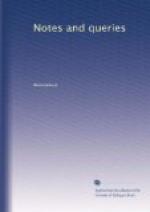The admirer of another epigram has not given it exactly as I can remember it in a little book of emblems more than fifty years ago:—
“’Tis an excellent world that
we live in,
To lend, to spend, or to give in;
But to borrow or beg, or get a man’s
own,
’Tis just the worst world that ever
was known.”
H. WALTER.
* * * * *
LETTERS OF QUEEN ELIZABETH AND PHILIP II. OF SPAIN.
Perhaps some of your readers may be able to inform me whether any of the following letters between Queen Elizabeth and Philip II. of Spain, extracted from the archives of Simancas, have yet appeared in print:—
1. Queen Elizabeth to Philip II., January 9, 1562-3.
2. Answer, April 2, 1563.
3. Philip II.’s reply to the English ambassador in the case of Bishop Cuadra, April, 1563.
4. Charges made in England against the Bishop of Aquila, Philip’s ambassador, and the answers.
5. Queen Elizabeth to Philip II., January 18, 1569.
6. Philip to Elizabeth, May 9, 1569.
7. Elizabeth to Philip, March 20, 1571.
8. Answer, June 4, 1571.
9. Declaration of the Council to the Spanish ambassador Don Gueran de Espes, Dec. 14, 1571.
10. The ambassador’s answer.
11. Elizabeth to Philip, Dec. 16, 1571.
12. Bermandino de Mendoza to Philip II., in cypher, London, January 26, 1584.
13. Philip to Elizabeth, July, 16, 1568.
14. Duke of Alva to Philip II., January 14, 1572.
15. Minutes of a letter from Philip II. to Don Gueran de Espes, February 24, 1572.
A.M.
* * * * * {103}
MINOR QUERIES.
The New Temple.—As your correspondent L.B.L. states (Vol. ii., p. 75.) that he has transcribed a MS. survey of the Hospitallers’ lands in England, taken in 1338, he will do me a great kindness if he will extract so much of it as contains a description of the New Temple in London, of which they became possessed just before that date. It will probably state whether it was then in the occupation of themselves or others: and, even if it does not throw any light on the tradition that the lawyers were then established there, or explain the division into the Inner and Middle Temple, it will at least give some idea of the boundaries, and perhaps determine whether the site of Essex House, which, in an ancient record is called the Outer Temple, was then comprehended within them.
EDWARD FOSS.
“Junius Identified.”—The name of “John Taylor” is affixed to the Preface, and there can be little doubt, I presume, that Mr. John Taylor was literally the writer of this work. It has, however, already become a question of some interest, to what extent he was assisted by Mr. Dubois. The late Mr. George Woodfall always spoke of the pamphlet as the work of Dubois.




